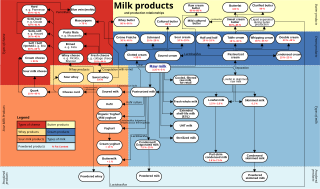
Dairy products or milk products, also known as lacticinia, are food products made from milk. The most common dairy animals are cow, water buffalo, nanny goat, and ewe. Dairy products include common grocery store food around the world such as yogurt, cheese, milk and butter. A facility that produces dairy products is a dairy. Dairy products are consumed worldwide to varying degrees. Some people avoid some or all dairy products because of lactose intolerance, veganism, or other health reasons or beliefs.
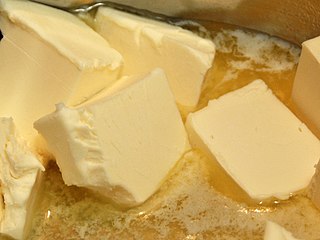
Butter is a dairy product made from the fat and protein components of churned cream. It is a semi-solid emulsion at room temperature, consisting of approximately 80% butterfat. It is used at room temperature as a spread, melted as a condiment, and used as a fat in baking, sauce-making, pan frying, and other cooking procedures.
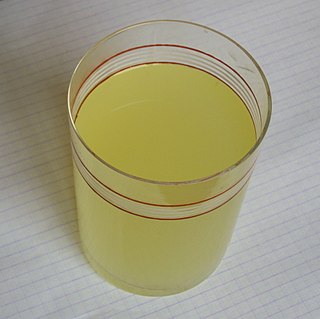
Whey is the liquid remaining after milk has been curdled and strained. It is a byproduct of the manufacturing of cheese or casein and has several commercial uses. Sweet whey is a byproduct resulting from the manufacture of rennet types of hard cheese, like cheddar or Swiss cheese. Acid whey is a byproduct brought out during the making of acid types of dairy products, such as strained yogurt.

Cottage cheese is a curdled milk product with a mild flavor and a creamy, heterogeneous, soupy texture. It is made from skimmed milk by draining curds but retaining some of the whey and keeping the curds loose. An essential step in the manufacturing process distinguishing cottage cheese from other fresh cheeses is the addition of a "dressing" to the curd grains, usually cream, which is mainly responsible for the taste of the product. Cottage cheese is not aged.

Buttermilk is a fermented dairy drink. Traditionally, it was the liquid left behind after churning butter out of cultured cream. As most modern butter in western countries is not made with cultured cream but uncultured sweet cream, most modern buttermilk in western countries is cultured separately. It is common in warm climates where unrefrigerated milk sours quickly.

Clotted cream is a thick cream made by heating full-cream cow's milk using steam or a water bath and then leaving it in shallow pans to cool slowly. During this time, the cream content rises to the surface and forms "clots" or "clouts", hence the name. Clotted cream is an essential ingredient for cream tea.

Eggnog, historically also known as a milk punch or an egg milk punch when alcoholic beverages are added, is a rich, chilled, sweetened, dairy-based beverage. It is traditionally made with milk, cream, sugar, egg yolks, and whipped egg whites. A distilled spirit such as brandy, rum, whiskey or bourbon is often a key ingredient.

Crème fraîche is a dairy product, a soured cream containing 10–45% butterfat, with a pH of approximately 4.5. It is soured with a bacterial culture. European labeling regulations specify the two ingredients must be cream and bacterial culture. It is served over fruit and baked goods, as well as being added to soups and sauces. It is used in a variety of other recipes. Sour cream is a similar foodstuff, except that crème fraîche is less sour and has a higher fat content. Sour cream may contain thickening agents not permitted in crème fraîche in many jurisdictions.
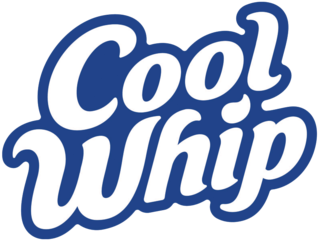
Cool Whip is an American brand of whipped topping manufactured by Kraft Heinz. It is used in North America as a topping for desserts, and in some no-bake pie recipes as a convenience food or ingredient that does not require physical whipping and can maintain its texture without melting over time.
Butterfat or milkfat is the fatty portion of milk. Milk and cream are often sold according to the amount of butterfat they contain.
Bulla Dairy Foods is an Australian dairy company that manufactures a national and export range of ice cream, table cream, yoghurt, sour cream, cottage cheese, and imitation cream under various brands. The business was established in 1910 and subsequently became a partnership among three inter-related families, who still continue to own and operate the business. The company's name was established from the origin of place in Victoria, Australia and the business has continued for more than 100 years. Bulla Dairy Foods has expanded internationally, exporting its products to 17 countries, as well as supplying their products nationally within Australia to supermarket retailers. The company employs more than 600 people across three manufacturing sites across Victoria in Colac, Dandenong, and Mulgrave and a head office and distribution centre in Derrimut, Melbourne. In 2015, Bulla Dairy Foods released a new campaign with the tagline "Unfakeable" to emphasise the company's Australian heritage.

Khoa, khoya, khowa or mawa is a dairy food widely used in the cuisines of the Indian subcontinent, encompassing India, Nepal, Bangladesh and Pakistan. It is made of either dried whole milk or milk thickened by heating in an open iron pan. It is lower in moisture than typical fresh cheeses such as ricotta. It is made up of whole milk instead of whey.
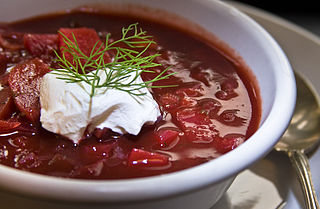
Smetana is the English-language name for the types of sour cream traditionally prevalent in Central, Eastern, and Southeastern Europe. It is a dairy product produced by souring heavy cream. It is similar to crème fraîche, but nowadays mainly sold with 9% to 42% milkfat content depending on the country. Its cooking properties are different from crème fraîche and the lighter sour creams sold in the US, which contain 12 to 16% butterfat. It is widely used in cooking and baking.

Whipped cream is heavy cream, double cream, or other high-fat cream that is whipped by a whisk or mixer until it is light and fluffy and holds its shape. Cream aerated by the expansion of dissolved gas, forming a firm colloid, is also called whipped cream. It is often sweetened, typically with white sugar, and sometimes flavored with vanilla. Whipped cream is also called Chantilly cream or crème Chantilly.

Strained yogurt, Greek yogurt, yogurt cheese, sack yogurt or kerned yogurt is yogurt that has been strained to remove most of its whey, resulting in a thicker consistency than normal unstrained yogurt, while still preserving the distinctive sour taste of yogurt. Like many types, strained yogurt is often made from milk enriched by boiling off some water content, or by adding extra butterfat and powdered milk. In Europe and North America, it is often made from low-fat or fat-free cow's milk. In Iceland, a similar product named skyr is made.

The fat content of milk is the proportion of milk, by weight, made up by butterfat. The fat content, particularly of cow's milk, is modified to make a variety of products. The fat content of milk is usually stated on the container, and the color of the label or milk bottle top varied to enable quick recognition.

Plant cream is an imitation of dairy cream made without dairy products, and thus vegan. It is typically produced by grinding plant material into a thick liquid to which gums are added to imitate the viscosity and mouthfeel of cream. Common varieties are soy cream, coconut cream, and cashew cream. It is used as a dessert topping and in many other dishes and beverages.
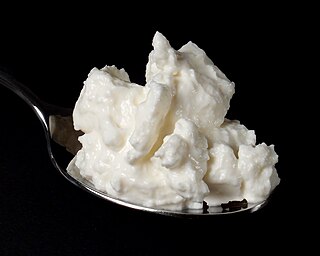
Quark or quarg is a type of fresh dairy product made from milk. The milk is soured, usually by adding lactic acid bacteria cultures, and strained once the desired curdling is achieved. It can be classified as fresh acid-set cheese. Traditional quark can be made without rennet, but in modern dairies small quantities of rennet are typically added. It is soft, white and unaged, and usually has no salt added.

Sour cream is a dairy product obtained by fermenting regular cream with certain kinds of lactic acid bacteria. The bacterial culture, which is introduced either deliberately or naturally, sours and thickens the cream. Its name comes from the production of lactic acid by bacterial fermentation, which is called souring. Crème fraîche is one type of sour cream with a high fat content and less sour taste.
Brinza de vaci, literally translated as “cow cheese”, is a type of fresh dairy product made from whole milk, the product resembles quark. It is traditional in the cuisines of Moldova, Romania and Slavic-speaking countries.





















